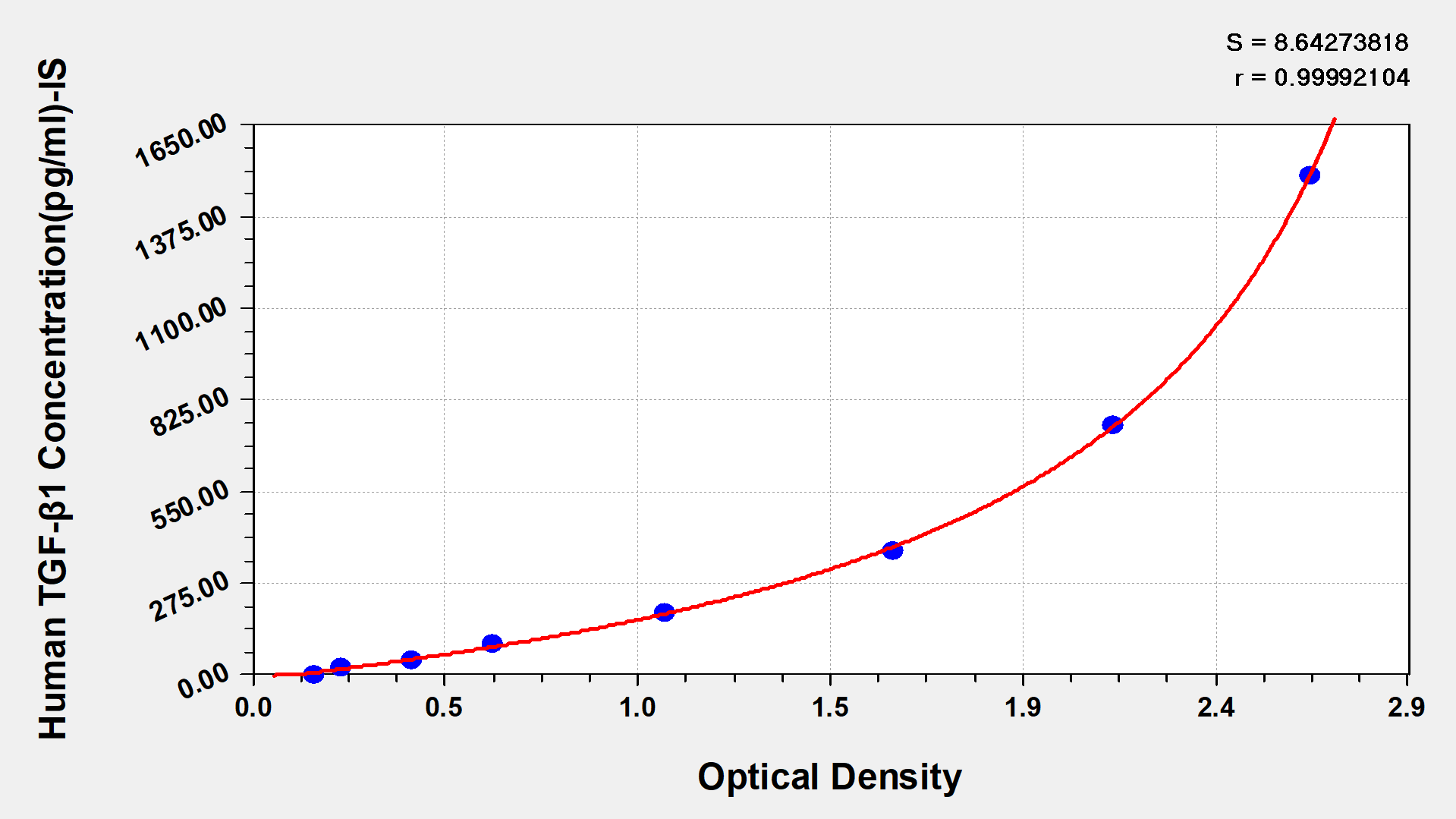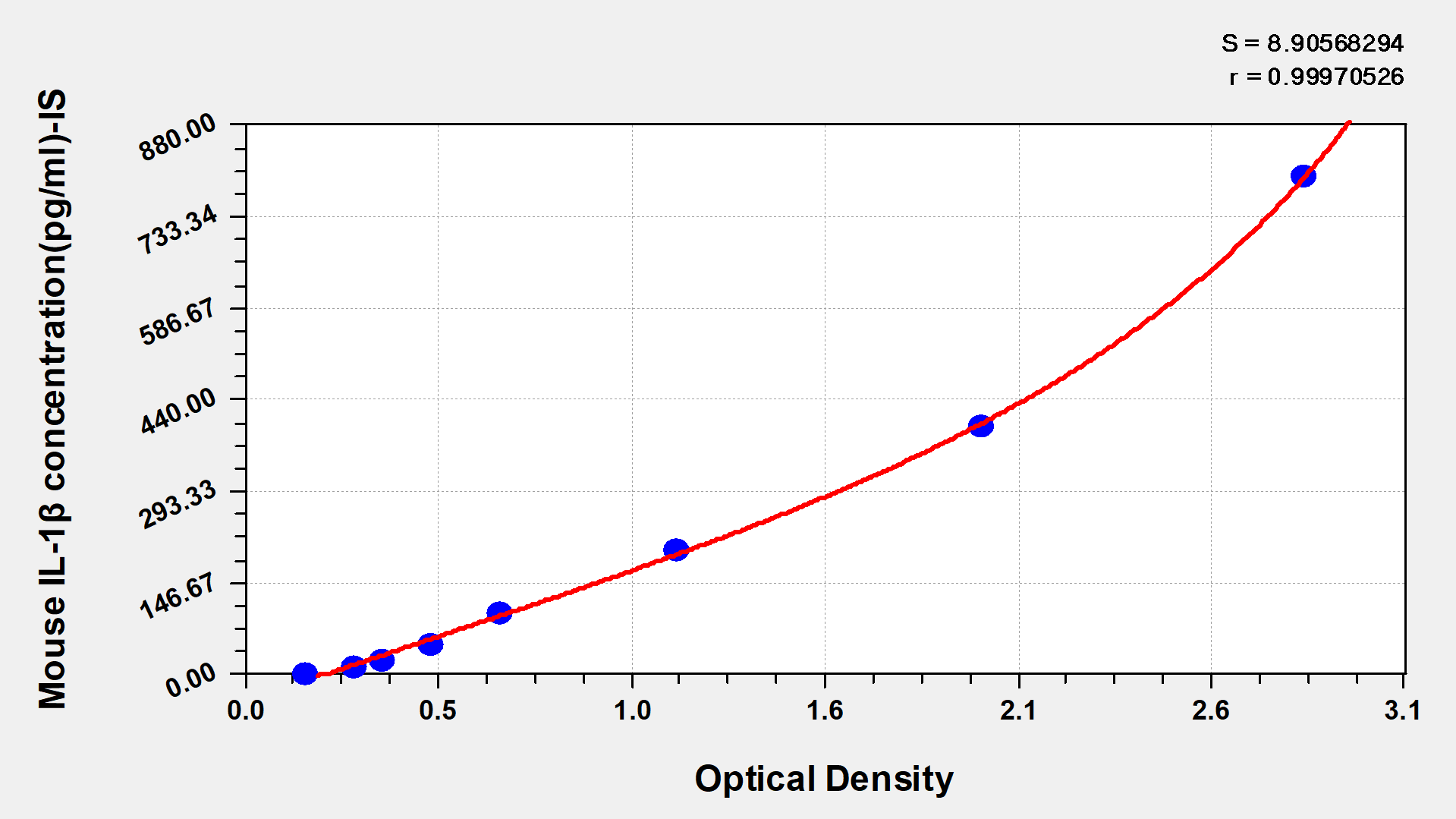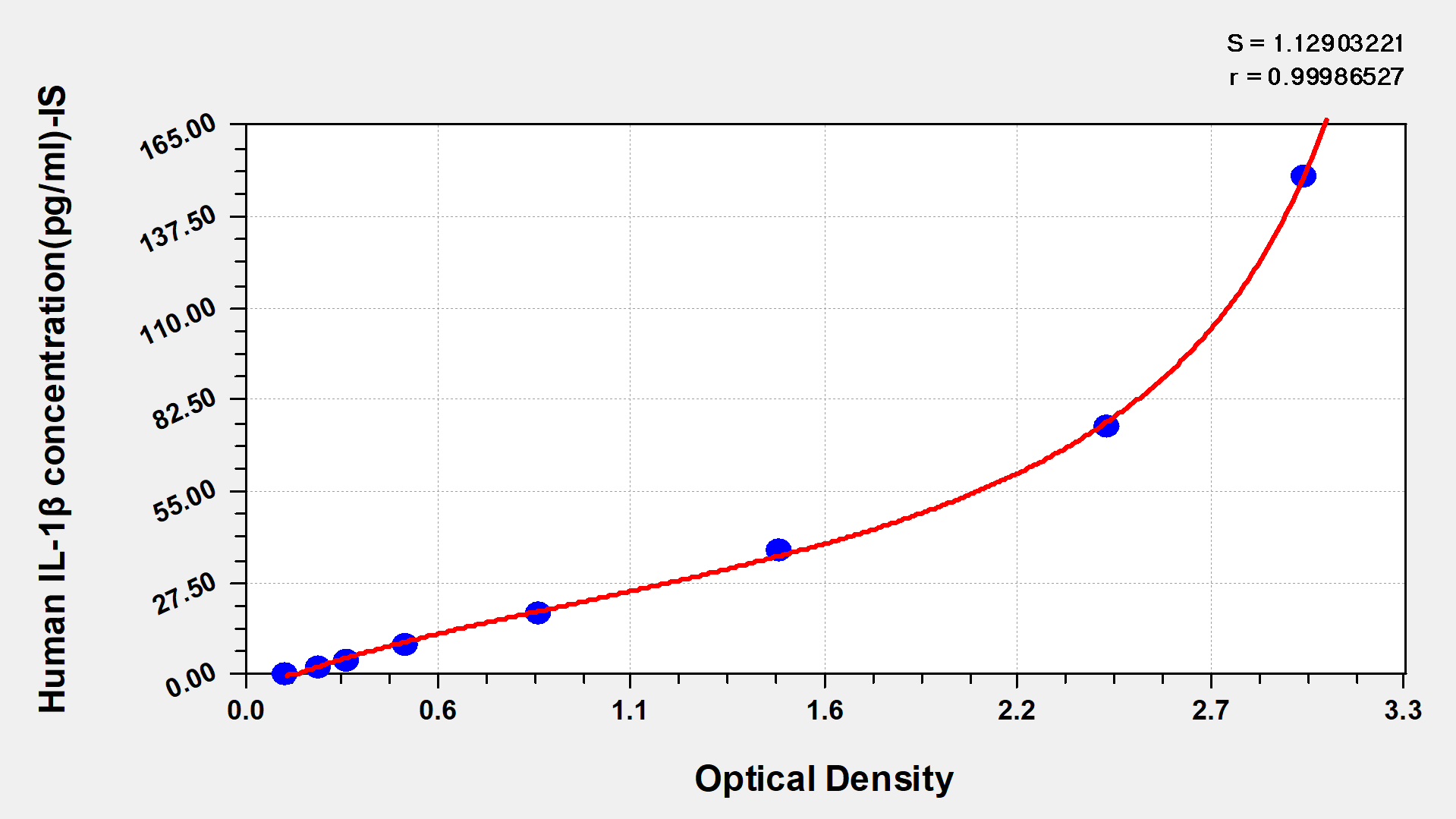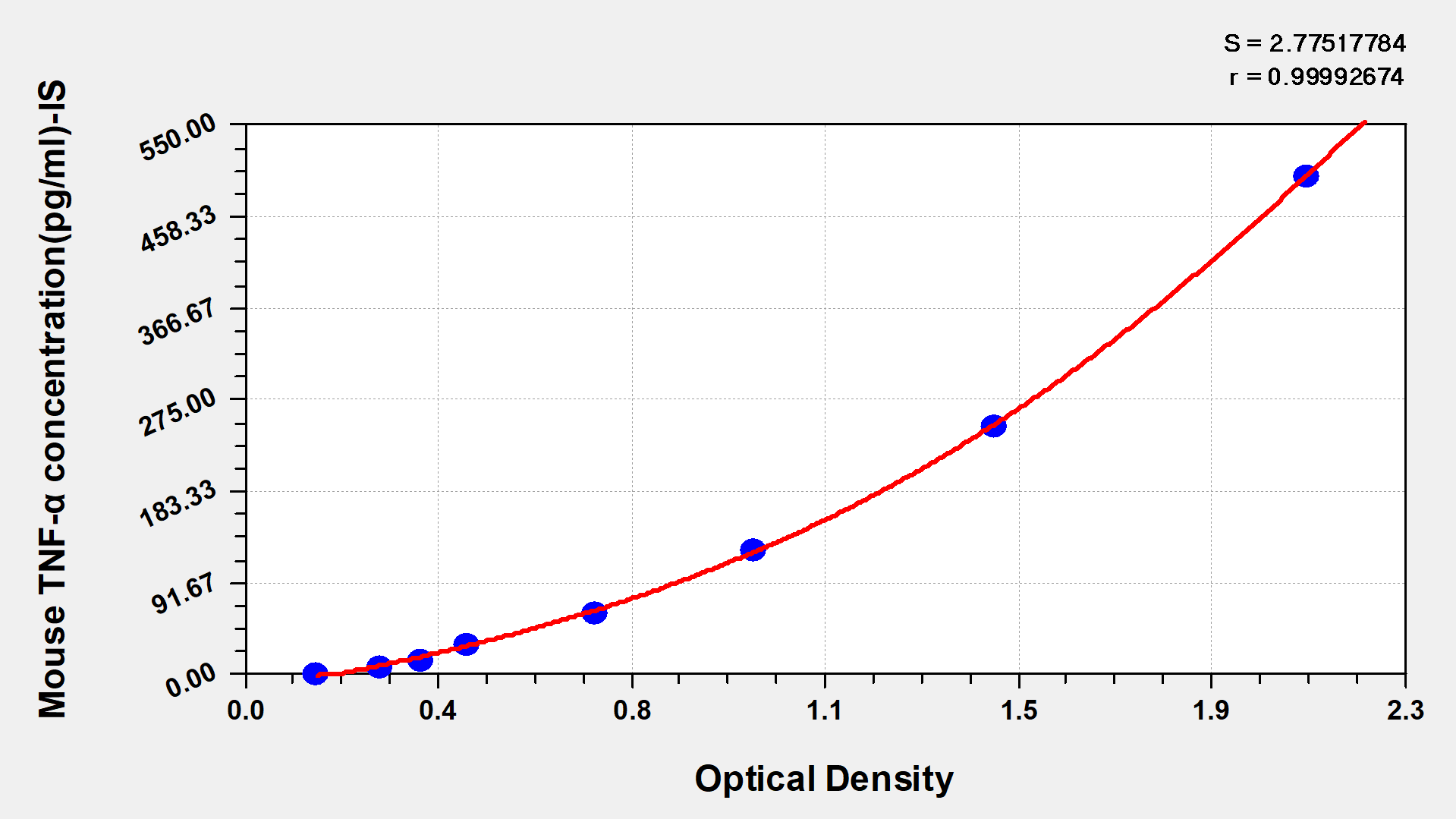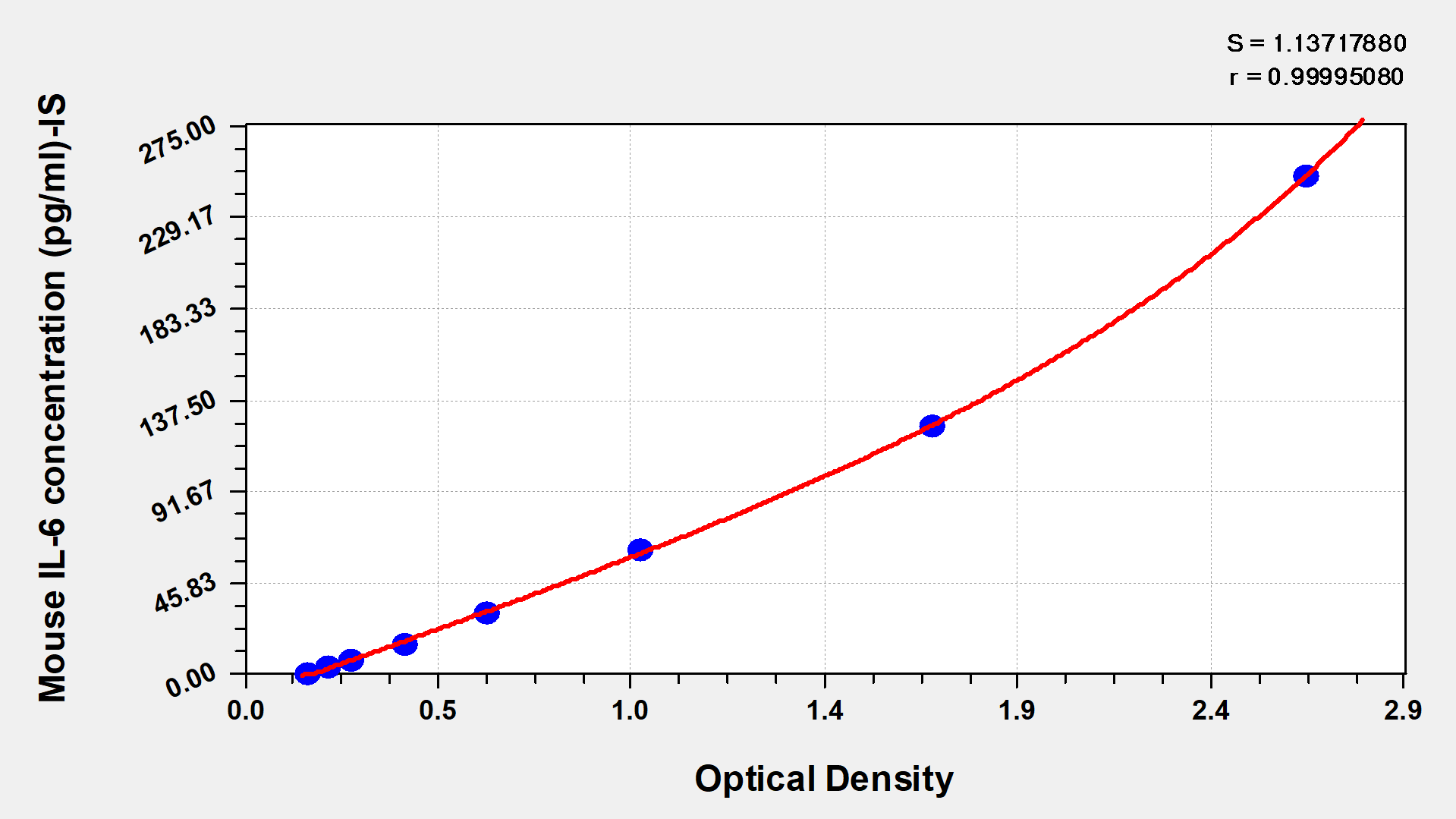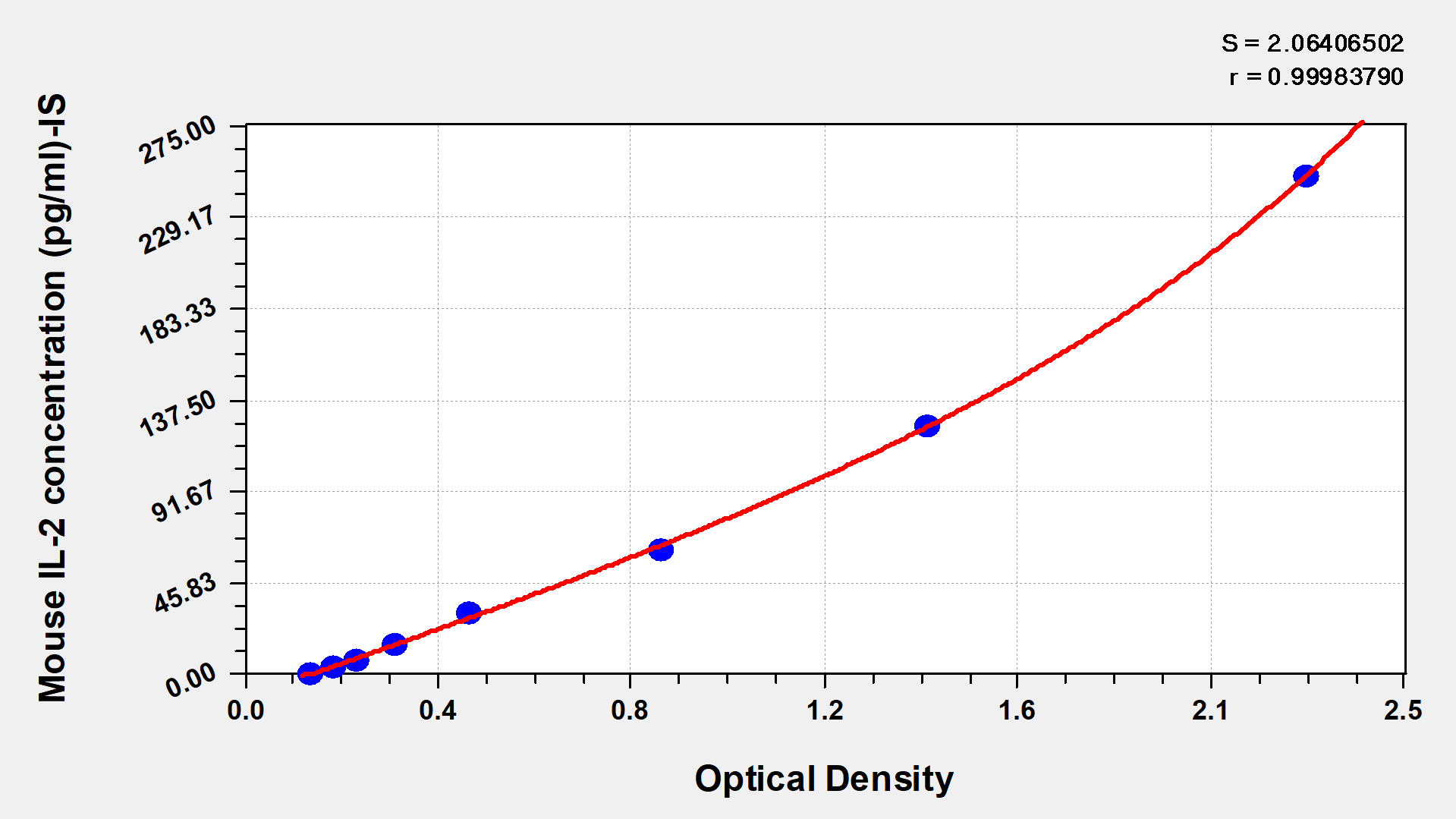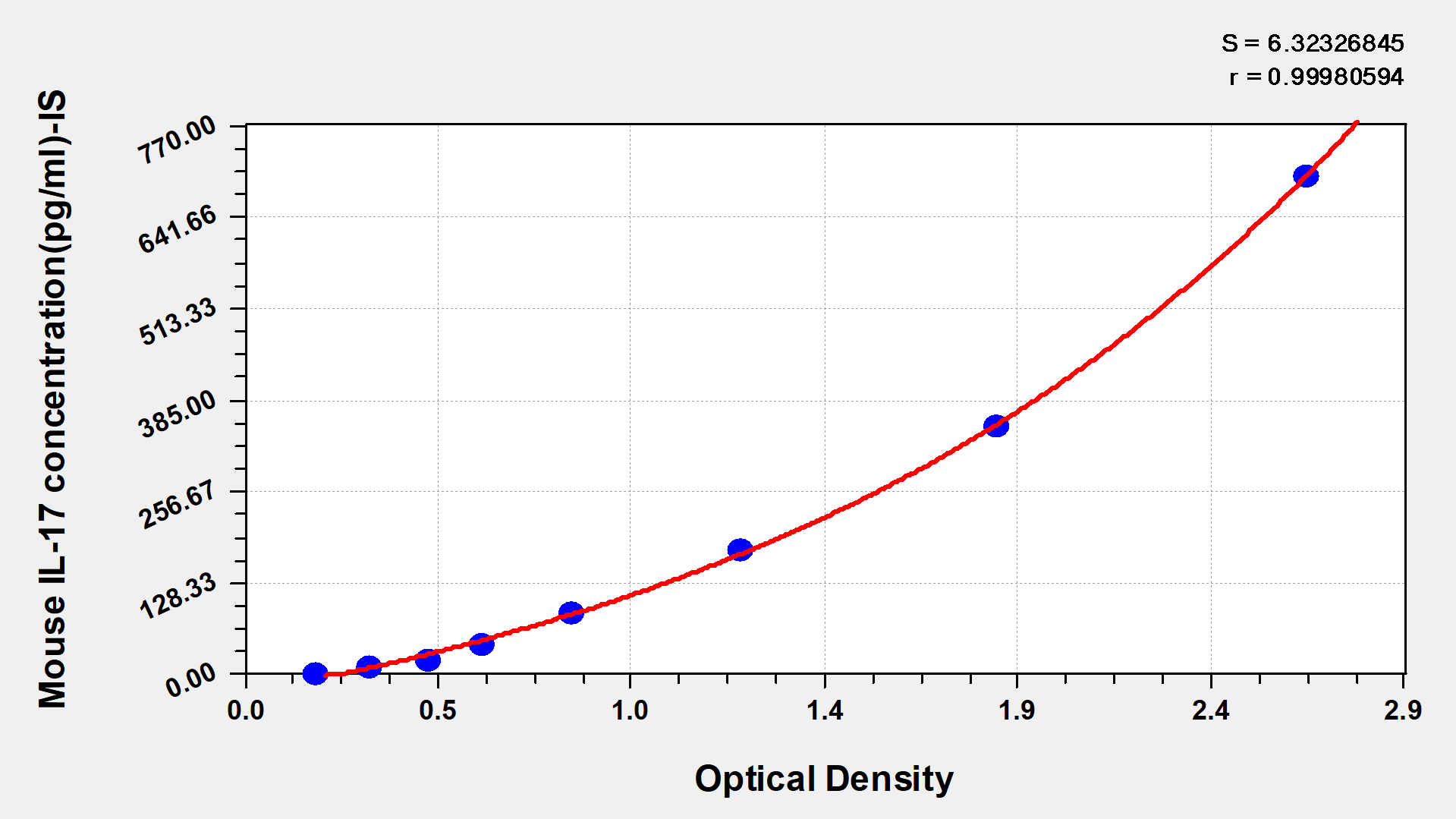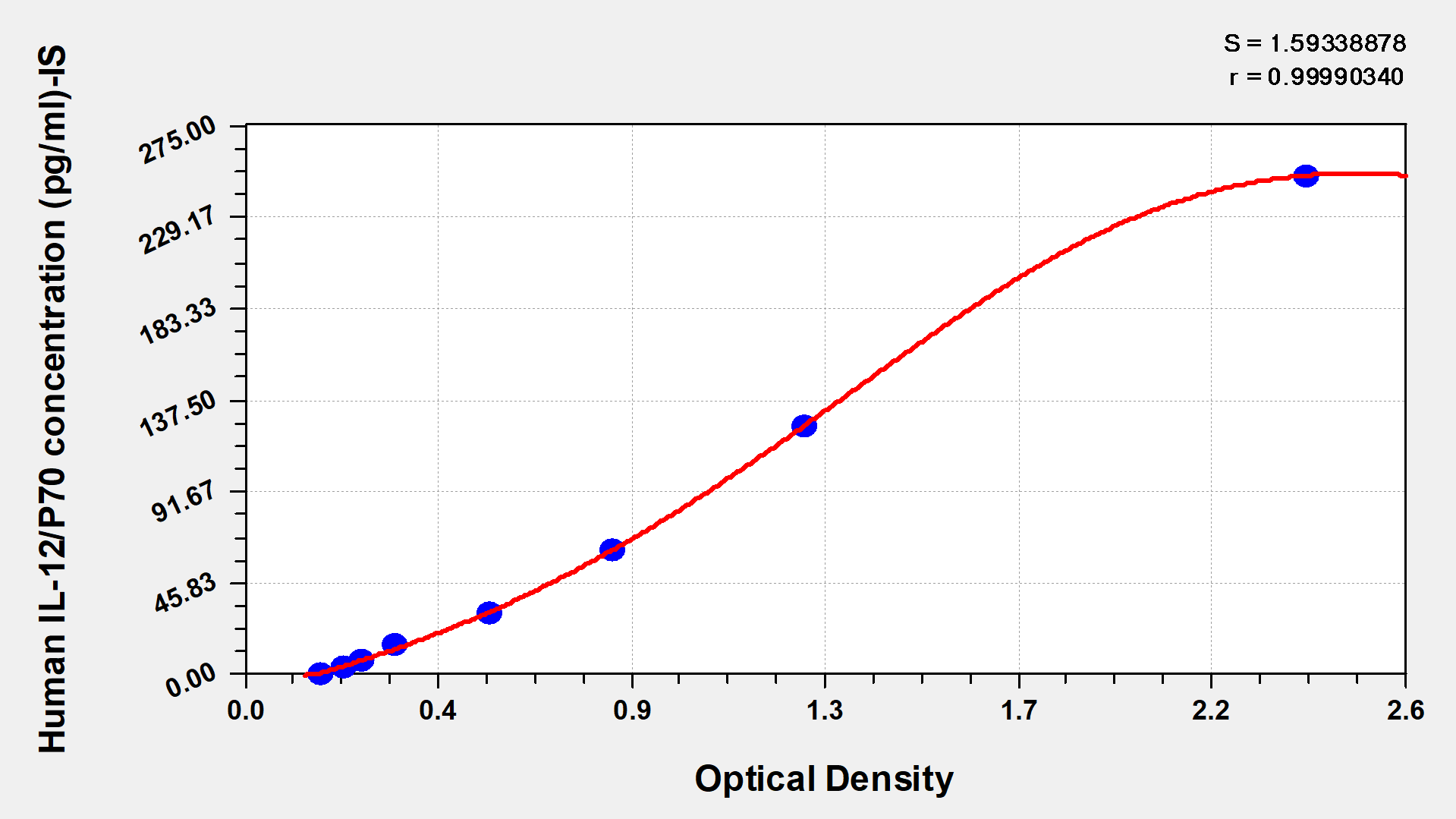Mouse Interleukin 1α,IL-1α ELISA kit
-
中文名称:
小鼠白介素1α(IL-1α)酶联免疫试剂盒
-
货号:
CSB-E04621m
-
规格:
96T/48T
-
价格:
¥3200/¥2500
-
其他:

产品详情
-
产品描述:
CUSABIO小鼠白介素1α(IL-1α)酶联免疫检测试剂盒(货号CSB-E04621m),采用双抗体夹心法原理,可定量检测血清、血浆及组织匀浆样本中2.35 pg/ml至150 pg/ml浓度范围的IL-1α蛋白,最低检测灵敏度为2.35 pg/ml。该试剂盒基于预包被特异性抗体的96孔板设计,通过生物素标记检测抗体与链霉亲和素-HRP系统实现信号放大,配套标准品与显色底物完成浓度测定。IL-1α作为重要的促炎细胞因子,广泛参与炎症反应、细胞增殖及免疫调节过程,其水平变化与感染性疾病、自身免疫疾病及肿瘤微环境调控密切相关。本试剂盒适用于科研领域中小鼠模型的炎症机制研究、免疫相关疾病动物模型的病理评估、药物干预效果分析等实验场景,配套实验缓冲液可即开即用,试剂组分需4℃运输并于-20℃避光保存,开封后标准品及检测抗体建议分装冻存,有效期12个月。
-
别名:
Il1aInterleukin-1 alpha ELISA Kit; IL-1 alpha ELISA Kit
-
缩写:
-
Uniprot No.:
-
种属:
Mus musculus (Mouse)
-
样本类型:
serum, plasma, tissue homogenates
-
检测范围:
2.35 pg/ml - 150 pg/ml
-
灵敏度:
0.58 pg/ml
-
反应时间:
1-5h
-
样本体积:
50-100ul
-
检测波长:
450 nm
-
研究领域:
Immunology
-
测定原理:
quantitative
-
测定方法:
Sandwich
-
精密度:
Intra-assay Precision (Precision within an assay): CV%<8% | | | |
Three samples of known concentration were tested twenty times on one plate to assess. | |
Inter-assay Precision (Precision between assays): CV%<10% | | | |
Three samples of known concentration were tested in twenty assays to assess. | | |
| Intra-Assay Precision | Inter-Assay Precision | Sample | 1 | 2 | 3 | 1 | 2 | 3 | n | 20 | 20 | 20 | 20 | 20 | 20 | Mean(pg/ml) | 18.596 | 18.529 | 18.512 | 18.426 | 18.546 | 18.495 | SD | 0.041 | 0.046 | 0.044 | 0.048 | 0.056 | 0.054 | CV(%) | 3.010 | 3.387 | 3.242 | 3.551 | 4.121 | 3.982 |
|
|
-
线性度:
To assess the linearity of the assay, samples were spiked with high concentrations of mouse IL-1α in various matrices and diluted with the Sample Diluent to produce samples with values within the dynamic range of the assay. |
|
| Sample | Serum(n=4) | 1:1 | Average % | 99 | Range % | 93-105 | 1:2 | Average % | 92 | Range % | 87-99 | 1:4 | Average % | 95 | Range % | 90-99 | 1:8 | Average % | 93 | Range % | 88-96 |
|
|
-
回收率:
The recovery of mouse IL-1α spiked to levels throughout the range of the assay in various matrices was evaluated. Samples were diluted prior to assay as directed in the Sample Preparation section. |
|
Sample Type | Average % Recovery | Range | Serum (n=5) | 93 | 90-98 |
|
-
标准曲线:
These standard curves are provided for demonstration only. A standard curve should be generated for each set of samples assayed. |
|
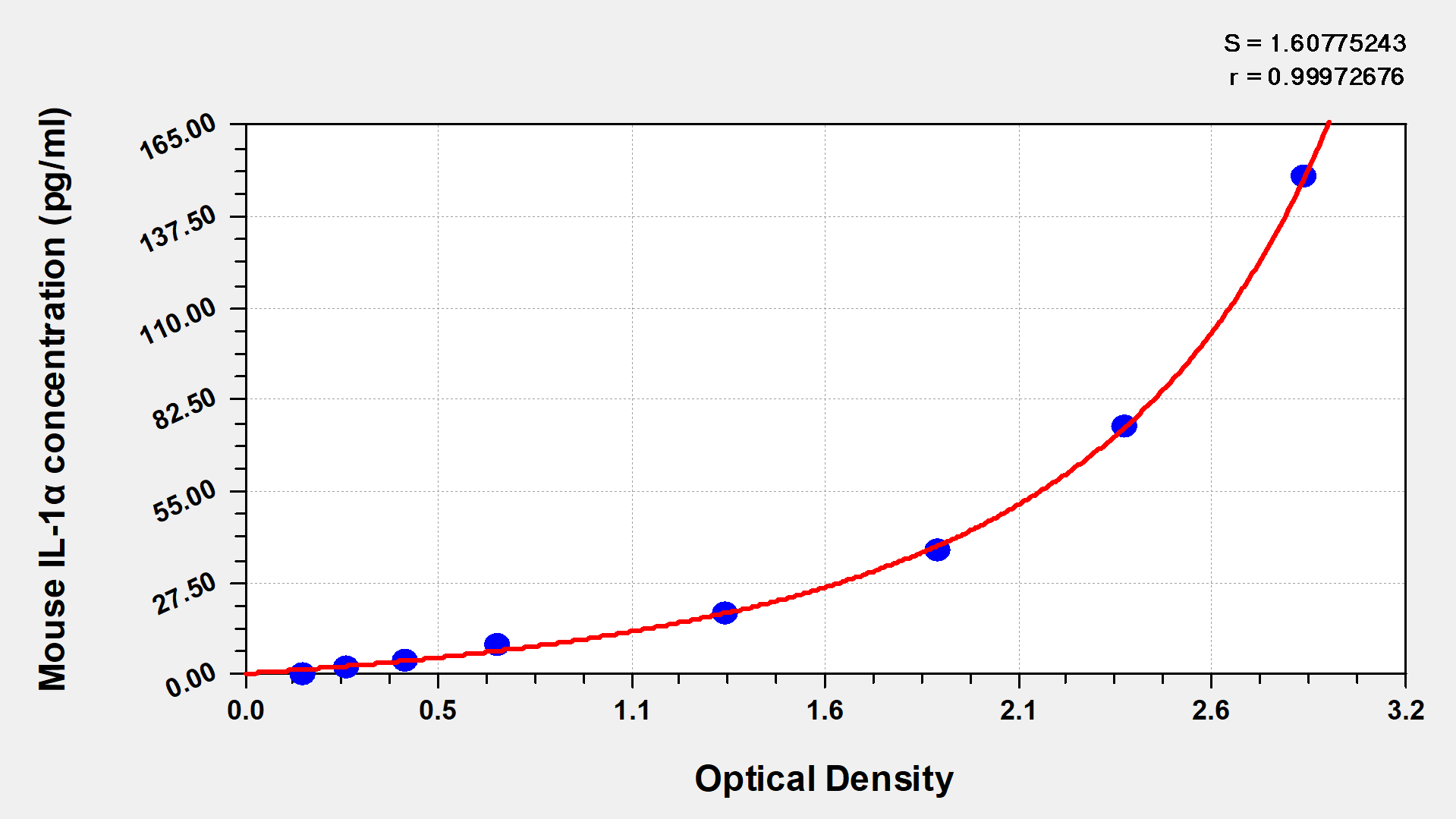
| | |
pg/ml | OD1 | OD2 | Average | Corrected | 150 | 2.901 | 2.887 | 2.894 | 2.72 | 75 | 2.461 | 2.345 | 2.403 | 2.229 | 37.5 | 1.971 | 1.828 | 1.900 | 1.755 | 18.75 | 1.362 | 1.278 | 1.32 | 1.146 | 9.38 | 0.717 | 0.689 | 0.703 | 0.529 | 4.69 | 0.458 | 0.447 | 0.453 | 0.279 | 2.35 | 0.298 | 0.281 | 0.29 | 0.116 | 0 | 0.175 | 0.173 | 0.174 | |
|
-
本试剂盒所含材料:
- A micro ELISA plate ---The 96-well plate has been pre-coated with an anti-mouse IL-1α antibody. This dismountable microplate can be divided into 12 x 8 strip plates.
- Two vials lyophilized standard ---Dilute a bottle of the standard at dilution series, read the OD values, and then draw a standard curve.
- One vial Biotin-labeled IL-1α antibody (100 x concentrate) (120 μl/bottle) ---Act as the detection antibody.
- One vial HRP-avidin (100 x concentrate) (120 μl/bottle) ---Bind to the detection antibody and react with the TMB substrate to make the solution chromogenic.
- One vial Biotin-antibody Diluent (15 ml/bottle) ---Dilute the Biotin-antibody.
- One vial HRP-avidin Diluent (15 ml/bottle) ---Dilute the HRP-avidin solution.
- One vial Sample Diluent (50 ml/bottle)---Dilute the sample to an appropriate concentration.
- One vial Wash Buffer (25 x concentrate) (20 ml/bottle) ---Wash away unbound or free substances.
- One vial TMB Substrate (10 ml/bottle) ---Act as the chromogenic agent. TMB interacts with HRP, eliciting the solution turns blue.
- One vial Stop Solution (10 ml/bottle) ---Stop the color reaction. The solution color immediately turns from blue to yellow.
- Four Adhesive Strips (For 96 wells) --- Cover the microplate when incubation.
- An instruction manual
显示更多
收起更多
-
本试剂盒不含材料:
- A microplate reader capable of measuring absorbance at 450 nm, with the correction wavelength set at 540 nm or 570 nm.
- An incubator can provide stable incubation conditions up to 37°C±5°C.
- Centrifuge
- Vortex
- Squirt bottle, manifold dispenser, or automated microplate washer
- Absorbent paper for blotting the microtiter plate
- 50-300ul multi-channel micropipette
- Pipette tips
- Single-channel micropipette with different ranges
- 100ml and 500ml graduated cylinders
- Deionized or distilled water
- Timer
- Test tubes for dilution
显示更多
收起更多
-
数据处理:
-
货期:
3-5 working days
引用文献
-
Иммунная составляющая патогенетической терапии атопического дерматита
ВД Боковой, МА Десятова, АВ Коротков,/,2024
-
PKM2 aggregation drives metabolism reprograming during aging process
J Bie,Nature communications,2024
-
Lipopolysaccharide released from gut activates pyroptosis of macrophages via Caspase 11‐Gasdermin D pathway in systemic lupus erythematosus
Y Xin,MedComm,2024
-
Vectorización de agentes terapéuticos a macrófagos para el tratamiento de procesos inflamatorios
MC Villa Hermosilla,/,2024
-
Prenatal and Postnatal Exposure to Polystyrene Microplastics Induces Testis Developmental Disorder and Affects Male Fertility in Mice
T Zhao,Journal of Hazardous Materials,2022
-
Thymoquinone counteracts oxidative and inflammatory machinery in carrageenan-induced murine paw edema model
HHA Hijazy,/,2022
-
The protective effect of selenium on the acute injury in S. aureus-infected mouse mammary gland
L Junjun,Research Square,2022
-
Protocatechuic Acid Counteracts Oxidative Stress And Inflammation In Carrageenan-Induced Paw Edema in Mice
A Albrakati,Researchsquare,2022
-
Diallyl Disulfide Suppresses Inflammatory and Oxidative Machineries following Carrageenan Injection-Induced Paw Edema in Mice
H Zhang,Mediators of Inflammation,2020
-
Cortex Phellodendri extract’s anti-diarrhea effect in mice related to its modification of gut microbiota
Xu B,Biomedicine & Pharmacotherapy,2019
-
Anti-Inflammatory and Anti-Hyperuricemic Functions of Two Synthetic Hybrid Drugs with Dual Biological Active Sites
Almeer R S, et al,International Journal of Molecular Sciences,2019
-
Cyanidin-3-O-glucoside ameliorates diabetic nephropathy through regulation of glutathione pool
YanQin.et al,Biomedicine & Pharmacotherapy,2018
-
β-Patchoulene from patchouli oil protects against LPS-induced acute lung injury via suppressing NF-κB and activating Nrf2 pathways
Chen XY.et al,Int Immunopharmacol,2017
靶点详情
-
最新研究进展:
IL1A是一种细胞因子,具有调节炎症和免疫反应的作用。最新研究发现,IL1A不仅在炎症和免疫相关疾病中发挥重要作用,还可能参与癌症的发生和进展。
-
功能:
Produced by activated macrophages, IL-1 stimulates thymocyte proliferation by inducing IL-2 release, B-cell maturation and proliferation, and fibroblast growth factor activity. IL-1 proteins are involved in the inflammatory response, being identified as endogenous pyrogens, and are reported to stimulate the release of prostaglandin and collagenase from synovial cells.
-
基因功能参考文献:
- Infection with Mycobacterium bovis results in increase in interleukin-1alpha, TGF-beta1, and MMP1 in multinucleated macrophages. PMID: 29504104
- Together, these data suggest that caspase-11/IL-1alpha pathway plays an important role in defending against Klebsiella pneumoniae by recruiting neutrophils in the early stage of infection. PMID: 28939441
- These data highlight an important interdependency between the potent pro-inflammatory cytokine IL1A and Fshr expression. PMID: 28337831
- Since neither IL-1alpha nor IL-1beta depletions completely rescued the phenotype, we believe that IL-1alpha and IL-1beta have a similar and probably complementary role in FHF progression PMID: 28953903
- These results suggested that Streptococcus pneuomoniae PLY induces the influx of calcium in Streptococcus pneumoniae-infected macrophages, followed by calpain activation and subsequent IL-1alpha maturation and secretion. PMID: 28630064
- In response to chemically induced colitis, this microbial landscape promoted the release of IL-1alpha, which acted as a critical driver of colitis and colitis-associated cancer. PMID: 27775548
- our results suggest that mature IL-1alpha induced by hS100A7 is via RAGE-p38 MAPK and calpain-1 pathway in keratinocyte and this mechanism may play an important role during psoriasis. PMID: 28060905
- Il-1 signaling pathway has a key role in abdominal aortic aneurysm formation in mouse model of Kawasaki disease. PMID: 26941015
- endothelial cells were identified as the primary cellular source of G-CSF during OPC, which responded to IL-1alpha that was released from keratinocytes in the infected tissue. PMID: 27632536
- Key aspects of IL-1alpha biology and regulation especially with regard to inflammation are reviewed. Review. PMID: 27434011
- data suggested that pINSd needs IL-1R1 for inflammatory cytokine induction. Mouse embryo fibroblast cells of IL-1R1-deficient mice further confirmed that pINSd promotes immune responses through IL-1R1 PMID: 27226621
- IL-1alpha signaling and DNA damage is important for triggering a sterile inflammatory cascade . PMID: 26439902
- As a dual function cytokine, IL-1alpha may contribute to the induction of CHOP intracellularly, while IL-1alpha released from necrotic cells accelerates steatohepatitis via induction of inflammatory cytokines by neighboring cells. PMID: 26022690
- These data demonstrate that DC and macrophages display distinct patterns of cytokine regulation, particularly with respect to IL-1, as a consequence of cell-type specific differences in the physicochemical properties of the P2X(7)R PMID: 26068648
- Data suggest the role of stromal cell IL-1alpha and IL-1beta in Kawasaki disease vasculitis model. PMID: 26515418
- IL-1alpha and IL-36alpha form a self-amplifying inflammatory loop in vivo that in patients with insufficient counter regulatory mechanisms may become hyper-engaged and/or chronic PMID: 26203636
- IL-1alpha-positive cells were identified in the epithelium in dextran sulfate sodium (DSS)-induced colitis. IL-1alpha was detected in the stool of colitic mice before IL-1beta. PMID: 25864926
- IL-1alpha acts as an alarmin essential for leukocyte recruitment and protective immunity against HSV-1 PMID: 25323745
- The aim of this study was to characterize the role of IL-1 in cellular responses of carbon nanotubes in cells from IL-1alpha/beta wild type (IL1-WT) mice. PMID: 25748835
- These findings do not support the previously suggested role of nuclear IL-1alpha in gene regulation of IL-1beta. PMID: 25748836
- the underlying mechanism by which AR influences AAA development is through IL-1alpha and transforming growth factor-beta1, and provides a potential new therapy to suppress/prevent AAA by targeting AR with ASC-J9. PMID: 26324502
- inhibition of this potentially important source of chronic inflammation in atherosclerosis requires blockade of interleukin-1alpha and not interleukin-1beta. PMID: 26139463
- The frustrated host response to Legionella pneumophila is bypassed by MyD88-dependent translation of pro-inflammatory cytokines. PMID: 25058342
- data suggest that central inhibition of IL-1alpha or Tox3 overexpression during the acute phase of a CNS insult may be an effective means for preventing the loss of neurological function PMID: 26224856
- Data (including date from studies in knockout mice) suggest that neutralization/deletion of Il1a reduces Il1b production and neutrophil infiltration in lung after inhalation exposure to silica nanoparticles. PMID: 25497724
- The controlled release of IL-1alpha could be a critical regulator during acute liver inflammation PMID: 25870999
- it appears the balance between TPO and IL-1alpha determines the MK cellular programming for thrombopoiesis in response to acute and chronic platelet needs. PMID: 25963822
- In acute lung injury, lipopolysaccharide induced alveolar macrophage necrosis via CD14 and the P2X7 receptor leading to interleukin-1alpha release. PMID: 25862090
- IL-1alpha induced the proliferation of CD11b(low) alveolar macrophages and differentiated these cells into CD11b(high) macrophages which perform critical phagocytic functions and organize granuloma. PMID: 25421226
- Data indicate that interleukin-1 cytokines IL-1alpha and IL-1beta are regulated by polyubiquitination and proteasomal degradation. PMID: 25371210
- IL-1 is a key mediator driving an innate immune response to inflammatory challenge in the mouse brain but is dispensable in extracerebral tissues including the lung and peritoneum. PMID: 25367678
- findings identify IL-1alpha as a crucial early danger signal triggering post-MI inflammation. PMID: 25505286
- Immune complexes inhibit IL-1 secretion and inflammasome activation. PMID: 25320279
- Selective deficiency of IL-1alpha in Kupffer cells reduces liver inflammation and expression of inflammatory cytokines, which may implicate Kupffer cell-derived IL-1alpha in steatohepatitis development. PMID: 24582082
- cigarette smoke-induced neutrophilia was dependent on IL-1alpha produced by alveolar macrophages and alveolar macrophages isolated from smoke-exposed mice were primed for excessive IL-1alpha production in response to bacterial ligands. PMID: 25092891
- tested the possible role of the proinflammatory cytokine IL-1 in the age-related exhaustion of ovarian reserve using IL-1alpha and IL-1beta-KO mice PMID: 25114230
- This study documents distinct roles for IL-1alpha and IL-1beta in the response to Pseudomonas aeruginosa infection as a function of the type 3 secretion system effectors produced by the infecting strain. PMID: 25069982
- necroptosis caused the processing and release of IL-1alpha, and this was independent of IL-1beta processing and release PMID: 24790078
- IL-1 induces systemic inflammation and augments Streptococcal pneumoniae infection, atherosclerosis, and ischemic brain injury via platelet activation and microvascular coagulation. PMID: 24644058
- IL-1alpha was not released upon inflammasome activation unless significant cell damage occurred. PMID: 23684408
- haematopoietic-derived IL-1 is a key driver of ischaemic brain injury. PMID: 23519030
- In severe S. aureus bacteraemia in mice, TNF-alpha, IL-1alpha, and KC are biomarkers predicting fatal outcome of infection. PMID: 23520553
- Our results establish IL-1alpha as a critical initiator of the inflammatory response to L. pneumophila PMID: 23686480
- discovery of a novel inflammatory circuit in which RIP1-mediated IL-1alpha secretion in response to deregulated SHP-1 activity triggers an inflammatory destructive disease that proceeds independently of inflammasomes and programmed necrosis PMID: 23708968
- Results suggest importance of IL-1R1/IL-1alpha to the recruitment and activation of dendritic cells in response to cigarette smoke exposure. PMID: 22992200
- ERalpha-regulated repression of TNFalpha and IL1alpha is important for lumen formation and maintenance. PMID: 22328525
- Allergic sensitization to HDM was abolished in vivo when IL-1alpha, GM-CSF, or IL-33 was neutralized. PMID: 22802353
- Autophagy has a potentially pivotal role to play in the induction and regulation of inflammatory responses by innate immune cells, largely driven by IL-1 and its consequential effects on IL-23 secretion. PMID: 22972933
- Vascular wall resident cells are the main targets for the pro-atherogenic effects of bone marrow-derived IL-1 through IL-1R1, partly by induction of adhesion and chemotactic molecules in endothelial cells. PMID: 22236482
- This study demonstrated here in in vivo experiments that IL-1 exacerbates the effects of SCI by accentuating the impact of the inflammatory responses. PMID: 22483094
显示更多
收起更多
-
亚细胞定位:
Cytoplasm. Secreted.
-
蛋白家族:
IL-1 family
-
数据库链接:
Most popular with customers




